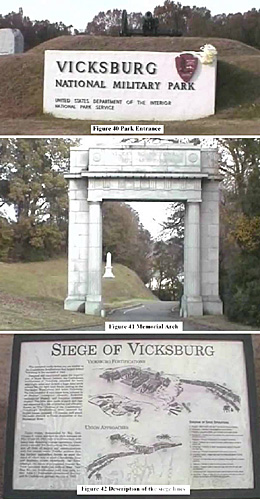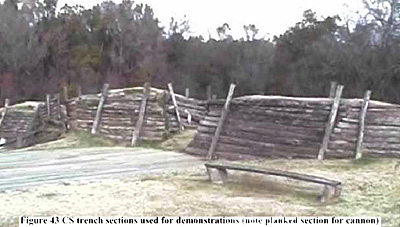 Today is 8 December and I am making the last of my planned ACW tours. I shall be
travelling to Vicksburg from Jackson (state capitol of Mississippi), which is about a 40-
mile distance. The weather began cool and foggy, and by the time I reached the park it
was sunny and warm (about 65F).
Today is 8 December and I am making the last of my planned ACW tours. I shall be
travelling to Vicksburg from Jackson (state capitol of Mississippi), which is about a 40-
mile distance. The weather began cool and foggy, and by the time I reached the park it
was sunny and warm (about 65F).
I took Interstate 20 to Exit 4B just inside the city limits and turned onto the road in front of the park entrance. This is a good way to go to the park as I-20 crosses I-55 in southern Jackson. I-20 parallels Highway #80, which is an older road that passes through some of the other interesting locations between Jackson and Vicksburg like the battlefields of Champion Hill and Big Black River.
Allie got me up early for her walk (0700 hours) so I set off early for the park. I expected it to be a long day of sightseeing so I wanted to reach the park early. My first stop was the visitors’ centre where I saw the 18-minute film on the campaign at 1000 hours. Next, I asked for a guided tour and was informed that it would take the guide, Sherry Henry, about 40 minutes to drive to the park as she and her husband (another guide) live outside of Vicksburg.
Sherry grew up in the area and knew a lot about the environs. I browsed through the bookstore and considered what to buy to add to my growing collection. I did not buy anything yet as I wanted to consult with Sherry for her recommendations.
Sherry arrived before 1100 and we set off on the 16-mile circuit of the park. Just over half of the route follows the US trenches and positions, and the remainder is behind the CS defensive lines. I gave Sherry my mini tape player so that she could record her presentation, while I used the video camera.
The tour began as we passed under the Memorial Arch near the visitors centre parking lot. This is close to #80 and leads into the first of many ravines or “hollows” that make this battlefield such an interesting visual experience. The defensive lines took advantage of the natural terrain, which is a combination of hills on top of a long series of bluffs along the Mississippi River and the ravines. The CS troops built a defensive wall with redans, redoubts, lunettes, and other strongpoints interspersed along the entire line from Fort Hill overlooking DeSoto Point and the Yazoo Diversion Canal to Fort Garrott at the southern end of the park’s scenic route.
There is another section that lies outside the park boundary (some of this land was exchanged for private property, although there are plaques on this land), but it is no longer contiguous and so the park does not enclose all of the CS defences now.
Sherry stated that the trees that now grow within the park were added to prevent soil erosion. Most of the land during the war was farmland so only a smattering of trees would have been present then. Again I was glad that I was visiting when the vegetation was sparse. The troops would have had much greater visibility and realised how close the lines were, in some cases only a few hundred metres apart.
 The park has a lot of plaques marking the disposition of the troops, the many points of
interest, information markers and monuments. These provide a clear representation of
where the troops were positioned and how the US forces advanced. A series of blue
plaques in front of the Union lines identify the gradual forward movement of the soldiers,
and mark some of the zigzag trenches that can still be seen. Ironically, there is not a
monument or statue for US General WT Sherman, although he played a significant part
in the campaign and was one of Grant’s most reliable subordinates (and friend). Of note,
the US government rather than a Confederate organisation or state funded CS General JC
Pemberton’s monument. Tiffany’s made some of the plaques, particularly those showing
the officers and men. Like many other battlefields, Vicksburg provides some outstanding
examples of American art. This is another park for artists and art historians.
The park has a lot of plaques marking the disposition of the troops, the many points of
interest, information markers and monuments. These provide a clear representation of
where the troops were positioned and how the US forces advanced. A series of blue
plaques in front of the Union lines identify the gradual forward movement of the soldiers,
and mark some of the zigzag trenches that can still be seen. Ironically, there is not a
monument or statue for US General WT Sherman, although he played a significant part
in the campaign and was one of Grant’s most reliable subordinates (and friend). Of note,
the US government rather than a Confederate organisation or state funded CS General JC
Pemberton’s monument. Tiffany’s made some of the plaques, particularly those showing
the officers and men. Like many other battlefields, Vicksburg provides some outstanding
examples of American art. This is another park for artists and art historians.
The 1917 reunion of veterans is also known as the “battle of the canes” as many of the elderly guests relied on walking sticks to get about (and obviously express themselves vigorously!).
The campaign is worthy of study even today as it featured many unique operations for its time. The amphibious landings at Bruinsburg were the first successful ones by American forces. Grant’s indirect approach to Vicksburg enabled his army to split CS Generals Pemberton and JE Johnston (based at Jackson) and cut the crucial supply lines east of Vicksburg. The cooperation between US army and navy forces, which were close and necessary to secure the victory, exemplified joint operations. The naval vessels had to run the gauntlet past the shore batteries along the east bank of the Mississippi in order to land the army forces at Bruinsburg. Overall, it was a model campaign for Grant, and obviously much less for Pemberton and Johnston.
Back to Sabretache # 6 Table of Contents
Back to Sabretache List of Issues
Back to MagWeb Master Magazine List
© Copyright 2003 by Terry Gore
This article appears in MagWeb.com (Magazine Web) on the Internet World Wide Web. Other articles from military history and related magazines are available at http://www.magweb.com